

 |
 |
||||
| Home | Reviews | Extras | Forums |
|
Azur LaneSynopsisThe human race has always set out to travel and, later, conquer the sea. All that changed with the appearance of the Siren. The old adage "war never changes" took on a whole new dimension when humanity was chased from the sea, and only the creation of shipgirls had the strength to stand against the onslaught. However, a disagreement over ideals lead to the creation of two factions. Crimson Axis, a faction made up of the Sakura Empire (Japanese) and Iron Blood (German) side of the original Azur Lane faction, split off from the Royal Navy (Great Britain) and Eagle Union (USA), because they had no compunctions about using Siren technology to fight the Siren, despite the danger of being used by said Sirens to begin with. And so, a three-way strife is set into motion that could only really serve the Siren. ReviewFour years ago plus some change, I wrote a review for Kantai Collection, an anime based on what is presumably the first game based around the concept of shipgirls fighting -- and often recreating -- naval battles centered around World War II. The game is, as far as I understand, a strategy game and one I never really had the chance to play, as it demanded an understanding of the Japanese language. As such, I was largely unfamiliar with the game and its many, many characters when I set out to review the anime. 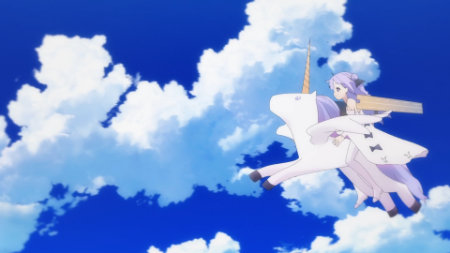  This is not the case with Azur Lane, however, as the game was released in English in May 2019, and I've been playing it more or less since then. As such, I have the distinct advantage of being familiar with most of the character who show up in the anime version, and in fact, it might be one of the things that works to the show's disadvantage; that you kind of have to be to get the full background on who all these girls are, especially since the ingame girls have formed friendship circles that cross the faction divide formed in this show. Like our "starter ships", Laffey, Javelin, Z23 and Ayanami -- three of which you get to choose between when you first start the game, and the selection differing depending on which server region you are in. That, and the game has had so many events and character stories the anime couldn't possibly hope to portray in a mere 12 episodes, and so it chose to base itself on a more or less original story that I haven't seen featured in the game. I'm going to try not to compare the two too much, seeing as Kantai Collection and Azur Lane have some slight differences to their approach, as Kantai Collection chose their main character and had most of the show centered around her. Azur Lane, however, chose a more established character as a main lead, namely the aircraft carrier Enterprise, but spreads its main focus out a bit. Also, given that there is also quite a lot of infighting between the girls in this show, some of them also take on various pseudo-antagonistic roles that shift and change as it progresses. Among the main ones are the Sakura Empire carrier Akagi and her sister Kaga, who seem to have a sceme going on that even their spiritual leader and battlecruiser Nagato doesn't know about. In a weird way, Azur Lane the game reserved some praise for avoiding the kind of revisionism Kantai Collection had by glorifying the Japanese navy and changing events that were based on real life. Rather, in the game, you will often face the selfsame girls from the Crimson Axis during the more serious moments, even if you have Iron Blood or Sakura ships yourself. The game explains this through the use of alternate timelines, in a sense, and random meetings with different versions of some of the girls, one of which shows up in this show as well. The main story is also largely driven by the meeting between Azur Lane girls Laffey and Javelin and Axis girl Ayanami, and the role the three of them will play in the upcoming war. (Z23, while there, doesn't play as large a part as the three others, at least not in this show.) The anime somehow also saw fit to introduce light carrier Unicorn into this dynamic, where in the normal game she mostly kept close to her "big sister" Illustrious. Whether the show intended it or not, there is a rather nice dichotomy between girls like her -- the younger generation who has only really started to experience what war means, but would rather not fight if they could avoid it -- and the older generation represented first and foremost by Enterprise -- who has fought so long that the stress of having experienced almost nothing else has started to take its toll, and they could scarcely imagine doing anything other than fighting. As the very beginning of Azur Lane covers the meeting between Laffey, Javelin and Ayanami through the latters' reconnaissance of the "enemy" base, the budding bond she shared with the two made it harder for her to fight them later, and vice versa. It needs to be mentioned, however, that game Enterprise and anime Enterprise differ the most in characterisation. In the game, Enterprise is a lot more like a regular big sister type and not the almost completely worn down veteran of the anime. In that same respect, the anime also shows us a lot more of the faction-split parts of the Sakura empire, and it's an almost wonderfully serene region, and just as the show chose to group up the girls more than in the game with Unicorn joining Laffey and Javelin in addition to some of the other Royal Navy and Eagle Empire destroyers, so does the Sakura girls form groups of their own beyond the sibling pairups you see. Hilariously, this extends to Royal Navy maid Belfast and her sudden interest in Enterprise's wellbeing, which caused a sudden increase in fanmade images shipping them -- pun very much intended, as it's adorable -- and eventually bleeding over to the game itself, if so far only in the very amusing "Juustagram" section. If I have made the Azur Lane anime sound more interesting than it really is, I'd like to stress that so far, I've only described most of the main appeals of the show itself. It is, in many ways, a fanservice vessel for people who have played and are familiar with the game. With the concept of the commander -- that is to say, you as the player -- and the whole affection mechanic taken out of the equation, Azur Lane comes across more like a "cute girls' daily activities" thing, broken up by various battle scenes, much like Kantai Collection did about four to five years ago. By and large, the show is pleasant enough if that's all you're looking for, but Kantai Collection had the slight advantage of being centered around a real-life event, which became more of a focus for the show itself. Azur Lane is centered more around a secret project based on Japanese legend (yet has nothing to do with that outside of providing an ominous name.) That in itself doesn't make the show less than its forebears, of course, but the way it's handled here is far more vague, and I sometimes feel like it's set up like this to allow the show more leeway to alter its content depending on how it's received. This has the unfortunate effect of making the show rather predictable on a generalized level: it's revealed rather early that Akagi and Kaga are working with the Siren, albeit not in the way one might think, and it goes to say that the two needs to be saved from their own plots before all of this is over.  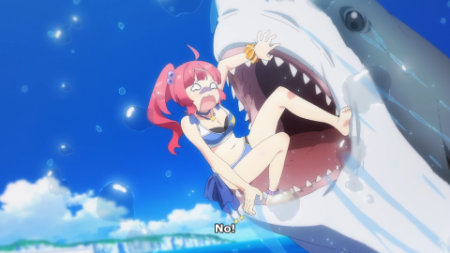  It doesn't help that the level of animation showcased in Azur Lane is pretty stale overall. The first episode actually looked rather nice, but while the show might look appealing in stills, action scenes aren't really animated that well most of the time, with some of the more low-key action scenes being downright awful. It's probably not for nothing the last two episodes were delayed for months -- I remember the same being the case for Girls und Panzer, a show that was animated quite a lot better than this -- and given that, at the time of writing, anime production is in a very serious place, maybe we should consider ourselves lucky that it wasn't delayed further. The background work is lovely, though; I am not ashamed to admit that the Sakura Empire surroundings had me slack-jawed upon its introduction, and if nothing else, the show does weather effects quite well. From a design perspective, the game had its character follow the same style as the Kantai Collection game; the girls in it wore special equipment that allowed them to replicate their original ship armaments, be that cannons, guns, airplanes and whatnot -- albeit with some leeway -- the anime for some strange reason had the girls stand on the decks of their own ships, which they could sort of absorb into themselves. Confusingly, Kaga gained the ability to summon a gigantic white multi-tailed fox with flight decks attached, which was featured in the first episode and then never again, while Unicorn's plushie.... well, unicorn... could move around on its own accord. Though in the case of the latter; according to some of her skins, so does it in the game, although not in the sense that she could make it expand in size so she could ride it. Seeing as the show basically abandoned this in its latter half, I'm guessing it received no welcome from its audience. So, the question remains; what is the appeal of this show? If you're looking for a purely action spectacle, Azur Lane is kinda OK, although the animation quality definitely leaves something to be desired there. The story likewise leaves something to be desired, as the game itself doesn't really go into what makes the Enterprise -- or as she's referred to here, the Grey Ghost -- tick. And if you haven't played the game at all, you aren't very likely to know why Akagi is so invested in this project, or where the character of Amagi fits into all of this. And there is the dichotomy of the anime: I already know all of this, as the game has filled me in through its many event storylines and character stories. I know who Amagi is, and why Akagi -- and even Kaga -- act the way they do in her absence because I've played the game, but that's the kind of thing the anime should fill us in on beyond the vague and somewhat stereotypical footage of her, as well as a somewhat younger pair of Akagi and Kaga. I don't want to compare the game too hard to Kantai Collection, but that show stood well enough on its own, so I didn't have to have played the game to know what was going on most of the time. The Azur Lane anime -- much like the game -- is also a little bit too happy to chew scenery for the sake of sounding important, which reflects its inability to tell a simple story without sounding mildly pretentious in the process. The one core of interest the show has is that the Siren makes for a more verbose villain for its purpose than the wordless rage of the Abyssals. In a weird way, they are the exact opposite of the Abyssals, as where the latter would be a personification of the anger and sadness left by the fallen and the ones left behind, the Siren represents more the cold, cynical and results-based part of warfare. Far from emotionless, though, they seem to take delight in the many clashes of the girls in the Azur Lane, even when things seemingly doesn't go their way. Which is probably because they're more interested in seeing what would happen if they interfere, in which case any consequence for their meddling would be good in their eyes. Mind you, the Siren are still a mystery to me in the game, so of course this anime isn't going to be able to fill me in much in that area either. 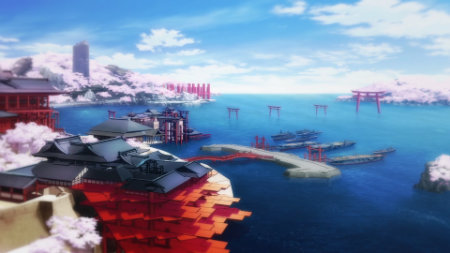 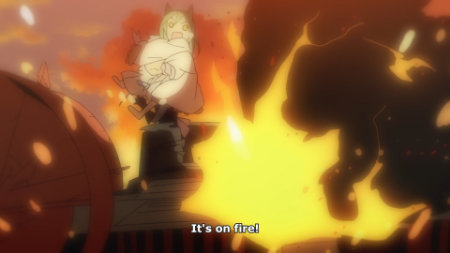 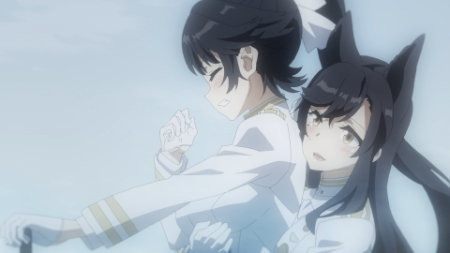 This leaves one thing, which is arguably the best part of the Azur Lane anime. The show does a pretty decent job at playing up the core friendships the show strikes up, mainly the ones between the Azur Lane faction of Laffey and Javelin and the Crimson Axis faction represented by Ayanami (and Z23 to a lesser extent), and even throws Unicorn a bone by including her in the group. Interestingly, despite their roles as pseudo-antagonists, the Sakura empire is portrayed as a good home for all the younger girls there, and while Ayanami's actions early in the show are clearly portrayed as misguided at best, she's clearly cared for by more people than just Laffey and Javelin. Meanwhile, Enterprise -- representing the older generation who has seen too much war and experienced little else -- more easily becomes the unwitting pawn for the Siren's plans, through the black mental cube which Azur Lane players will recognize as the item that will let you gain more girls to your fleet, but in this case serves as more of a macguffin for the story to run all the way to its somewhat predictable end. And of course the show is not lacking in characters. While a small handful of them serve as the main cast, whose job it is to drive the story forward; if you have any favorites on the sidelines, there's a good chance you'll see them at some point, doing their regular, character-defining thing. (And yes, that includes Glowworm doing her trademark "head smash" move.) It's not the deepest thing you'll ever see, but due to the aforementioned scenery-chewing and secrecy-obsessed monologues, you'll appreciate their small moments of levity nonetheless. Azur Lane is honestly mostly enjoyable, and the story is fairly straightforward as action spectacles -- with serene downtimes -- go. The dialogue might be a little bit on the nose with its messages, though, and as a standalone story, it's a bit too weak compared to a lot of the stuff you experience through the game. This is partially because unlike a lot of said events, it's not based on something that happened in our own World War 2, which would actually have benefited the show more if they had done this, as it would not have been as dependant on a game you may or may not have played. As it stands, the Azur Lane anime feels made for the players of the game and nobody else. Yes, the show tries to explain as best it can to make up for this, but you can't really sum up everything that happens in the game with even a handful of monologues. In a sense, this whole anime is built up like a limited event in the game, and for better or worse, that's what you are going to get. This is made more for the players of the game than those outside of it. If you have the game and is at least halfway familiar with all the events in it -- and aren't too picky on animation quality -- you can add one star. — Stig Høgset Recommended Audience: Being an action show about girls born in the image of real-life battleship, I think it's safe to say that the show has its share of violence. But while it might not play down the casualties of war much, nobody in the show seems to suffer much of the more typical consequences of being a soldier; missing limbs, scars, wounds and the likes. Version(s) Viewed: Digital stream on European streaming service Wakanime. Review Status: Full (12/12) Azur Lane © 2019 Manjuu Co., Ltd., Yongshi Co., Ltd. & Yostar, Inc./Anime "Azur Lane" Production Committee |
 |
|
| © 1996-2015 THEM Anime Reviews. All rights reserved. |